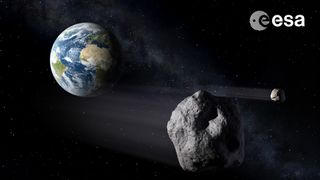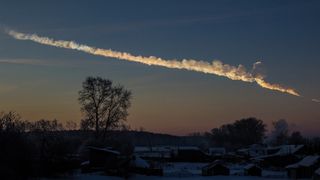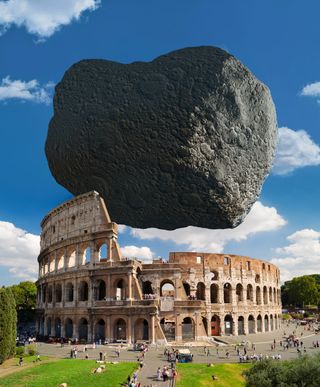Asteroid apocalypse: How big must a space rock be to end human civilization?
The damage caused by an asteroid impact depends on its size. But how big must a space rock be to cause an apocalypse?

Space rocks burning up in Earth's atmosphere are the cause of beautiful shooting star displays. When these occur, you are meant to close your eyes and make a wish. But when the incoming meteorite gets too big, the only wish you can reasonably make is not to be anywhere near its impact site.
But how big must an asteroid be to no longer be just a mesmerizing sight? What size is big enough to wreck a whole city or a continent? And what else does the damage depend on?
Fragments of space rocks are omnipresent in space. About 48.5 tons (44 metric tonnes) of meteorites hit Earth each day, according to NASA. Most of these fragments are as tiny as a grain of sand and burn up without any fuss immediately upon entering Earth's atmosphere. The Planetary Science Institute estimates that for a piece of space rock to make it all the way to the ground, even as a small pebble, it would have to be at least 16 feet (5 meters) wide when it first meets the atmosphere. Such rocks, however, are much less frequent. According to NASA, a meteorite as big as a car encounters our planet about once a year. One the size of a football field will cross our planet's path about once every 2,000 years. But when that happens, what exactly will occur on Earth?
Here we look at a couple of case studies to give you an idea of what you might expect.
Related: NASA's DART asteroid crash is a rare opportunity for space-rock scientists
1. Chelyabinsk: 66 feet wide (20), the size of a tennis court
In February 2013, a dazzling fireball zipped across the morning winter sky near the city of Chelyabinsk in south-eastern Russia. As the streak of light approached the snow-covered landscape, it brightened up, eventually exploding about 19 miles (30 kilometers) above ground and briefly outshining the sun. The shockwave generated by the explosion, which unleashed about ten times as much energy as the nuclear bomb dropped on the Japanese city of Hiroshima at the end of the Second World War, shattered windows on thousands of buildings and even destroyed the roof of a local zinc factory. More than 1,400 people were injured. A piece of rock over 1,100 pounds in mass (500 kilograms) and several other smaller fragments were later found in a nearby lake.
A space rock the size of the Chelyabinsk meteorite is at about the cut-off point for concern, Gareth Collins, a professor of planetary science at Imperial College London, told Space.com.
Get the Space.com Newsletter
Breaking space news, the latest updates on rocket launches, skywatching events and more!
"Chelyabinsk did cause quite a lot of injuries and quite a lot of damage, but it wasn't a sort of extreme threat to life," Collins said. "The meteorite arrived at quite a shallow angle, which meant the center of the explosion was quite high up. It would have been worse had it come in at a steeper trajectory."

2. Tunguska: 156-foot-wide (50 m), the size of an Olympic swimming pool
In 1908, an asteroid believed to be 160 to 190 feet wide (50 to 60 m) exploded above Eastern Siberia near the Tunguska river, flattening 80 million trees over an area of 830 square miles (2,150 square kilometers). Eyewitnesses described a heat blast followed by powerful earth tremors and a pressure wave that threw people into the air. Collins points out that although it was only a little over twice as wide as the Chelyabinsk rock, the Tunguska asteroid was in fact ten times more massive and therefore unleashed much more energy when it exploded in the atmosphere. No crater was ever discovered, and the damage to properties and injuries to humans was limited by the remoteness of the area.
If, however, an asteroid of a similar size were to explode over a city like London or New York, the damage would be wide-reaching. Collins and his team created an online tool that enables researchers (and members of the public) to explore impacts of asteroids in different parts of the world by altering basic parameters such as the size of the asteroid, the material the rock is made of and its speed. The tool shows that if an asteroid the size of Tunguska fell, for example, on the city of London, the destruction would be felt even in the city's most remote suburbs.
"An event of that magnitude over a big conurbation would be extremely hazardous," said Collins. "The blast pressures would be sufficient to knock down trees and fencing, break windows, destroy some roofs and maybe even some buildings. It probably wouldn't be sufficient to cause severe damage to well constructed buildings like bridges and skyscrapers."
While many would be injured by the amount of flying debris, a Tunguska-sized asteroid wouldn't cause "a complete annihilation," Collins added. The damage would be more severe, however, if the asteroid was made of a denser metal-rich material, rather than stone (like Tunguska was). Such an asteroid would likely survive the descent through the atmosphere as a larger fragment and create a crater on the ground.
"The Meteor Crater in Arizona was probably created by an asteroid of a similar size as Tunguska," said Collins. "But because [the asteroid] was made of iron, it was able to punch through the atmosphere, hit the ground and form a mile-wide (1.6 km) crater."

3. A 330-foot-wide (100 m) asteroid, the size of a soccer field
Things get more dramatic as the asteroids get bigger. If the stray rock were over 330 feet wide (100 m), it would create a crater no matter what material it was made of. The pressure blast would also be much more damaging, as the space rock would discharge most of its energy closer to the ground, said Collins.
"The asteroid would vaporize so close to the ground that there would be extreme heating," said Collins. "It might be enough to melt the ground and ignite fires in the area closest to the explosion."
The pressure blast would destroy buildings up to 9 miles (15 km) from ground zero, and windows would shatter more than 60 miles away (100 km). To make matters worse, as the partially burned rock hit the ground, it would trigger seismic tremors that would spread through the planet's crust, carrying the destruction further away from the epicenter. The debris ejected into the air by the force of the impact would rain back on the ground miles away from the impact site, and the finer dust and dirt would remain hanging in the air, spreading with the wind across large distances.
4. 525-foot-wide (160 m): what if Dimorphos were to hit Earth?
Dimorphos, the target of NASA's asteroid-smashing DART mission, is not on a collision course with our planet. But what would happen if a rock as big as Dimorphos were to sneak upon us?
"If [an asteroid as big as Dimorphos] were to fall on the city of London, windows would break over the whole south east of England and the damage in [the Greater London] area would be very extreme," Collins said. "There would be no survivors in the center of London because of the impact itself and also because of the severity of the air blast."
The crater produced by the impact would be over a mile wide (1.6 km) and over 1,200-foot-deep (370 m). However, Collins said, the probability of any space rock falling on a densely inhabited area is extremely low. Because 70% of Earth is covered with oceans, we might as well get perfectly lucky, and experience no effects at all.
"If the asteroid fell into the ocean, it would produce very large tsunami waves," said Collins. "But if it happened deep in the ocean, the waves would dissipate to quite low amplitude waves before reaching the coast."
The ocean, however, would not offer any protection if the asteroid were to crash too close to the coast, into the shallow water of the continental shelf.
"That would produce a tsunami wave that would impinge on the coastline over a very broad region," said Collins.
While asteroids of this size crossing the path of our planet are rare, astronomers estimate that 60% of near Earth asteroids larger than 140 meters are still unknown.

5. 2,560-foot-wide (780 m), the size of Didymos
What about the 2,560-foot-wide (780 m) Didymos, the larger rock around which Dimorphos orbits? Things can get really scary with asteroids of this size. According to Collins' modeling, such an asteroid would carve a permanent crater more than 7 miles wide (11 km) and more than 2,030 feet deep (619 m) when it impacts. Devastating tremors of a magnitude 7.4 on the Richter scale would propagate through the planet's crust and would still be felt by humans as far as 300 miles (500 km) from the impact site. The air pressure wave would shatter windows more than 1,000 miles (1,600 km) from the impact site. If London were ground zero, windows would still be shattered in France and the Netherlands.
The good news is that the larger the asteroid, the rarer it gets. On top of that, astronomers believe that all near-Earth rocks (and comets) larger than 0.6 miles (1 km) have already been found, and none is on the trajectory to hit us any time soon.

What determines the effects of an asteroid impact?
How much destruction an asteroid wreaks depends on several factors. Most important is its mass and the velocity at which it zooms through Earth's atmosphere before disintegrating or hitting the ground, Collins said. The exact equation for the amount of energy the asteroid blast discharges is its mass multiplied by its velocity squared, said Collins. But there are other variables that influence how widespread the devastation will be. Here we look at the most important ones.
1. Mass of the asteroid
Astronomers most commonly describe asteroids by their size, but what really matters is the mass. That is the asteroid's volume times its density. Astronomers assume that quite significant differences exist in the density of different types of asteroids. Carbon-rich asteroids, the most common type in the asteroid population, can have densities of less than 1.4 grams per square centimeter. Some, so-called rubble piles which are loose conglomerations of pebbles and rocks, can be even less dense. Stony, silicon-rich asteroids can be twice as dense as the carbonaceous ones, while the rare metal-rich asteroids can have densities of over 5.3 g/cm^3. That means a round space rock 66 feet wide (20 m) would have a mass of 6459 tons (5,860 metric tonnes) if it were a carbonaceous asteroid, 12,458 tons (11,302 metric tonnes) if it were a stony silicon-rich asteroid, and a 24,455 tons (22,186 metric tonnes) if it was mostly made of metal. For comparison, NASA's Space Launch System moon rocket weighs about 2,750 tons (2,495 metric tonnes).
The denser the asteroid, the likelier it is to survive the passage through the atmosphere and smash into the ground, creating a crater.
2. Speed of the asteroid
The ferocity of the impact and the strength of the shockwave that an asteroid hurtling through Earth's atmosphere can trigger also depends on its speed, Collins said.
Asteroids zip through the solar system at different speeds. How fast they move varies based on the shape of their orbit around the sun. Asteroids following more elliptical orbits speed up as they near the sun, reaching higher speeds than the more leisurely travelers on more circular obits. Space rocks can collide with Earth's atmosphere at velocities ranging from 7 miles per second (11 kilometers per second) to 25 mps (40 km/s), with 12.5 mps (20 km/s) being the average speed of the encounter, said Collins.
"If an asteroid is traveling much faster, it's bringing with it a lot more energy, and therefore can be a lot more devastating," said Collins.
3. Angle of entry during descent
The devastation on the ground will also depend on where and how the asteroid releases most of its energy. That will depend on the altitude at which it explodes, which in turn will depend on the angle at which it enters the atmosphere.
If the asteroid arrives at a rather shallow angle, its journey through the atmosphere will be longer and therefore it will slow down and discharge its energy more gradually than if its path were more perpendicular to Earth's surface. An asteroid on a shallow trajectory will likely disintegrate higher up in the atmosphere compared to one falling straight down, and therefore the impact on the ground will be less severe, although it might affect a wider area, said Collins.
"The asteroid that comes at a steeper angle decelerates more rapidly so it deposits more energy over a smaller part of the atmosphere," said Collins. "It also gets closer to the ground before it transfers most of that energy to the air, and the closer to the ground the source of the explosion is, the stronger will be the strength of the blast wave when it reaches the ground."
4. Where the asteroid hits
The good news is that statistically, every space rock has a high probability of falling into the ocean or onto some sparsely inhabited area of the planet. Despite overpopulation concerns, the majority of Earth is still the realm of wilderness rather than humankind, and chances are that as long as the asteroid is not too large, we might be spared the worst of its impact.
The Earth's ocean, Collins said, might be able to cushion strikes by even quite large asteroids, more than 333 feet wide (100 m), as long as they land sufficiently far away from the shore.
"An asteroid falling into the ocean, that is probably the likeliest scenario," said Collins. "The impact would produce very large tsunami waves, but if that happened deep in the ocean, those waves would probably dissipate to quite low amplitude waves before they reach the coast. Probably the most damaging scenario would be if this event happened in the continental shelf, just off the west coast of the U.S., for example."
Follow Tereza Pultarova on Twitter @TerezaPultarova. Follow us on Twitter @Spacedotcom and on Facebook.
Join our Space Forums to keep talking space on the latest missions, night sky and more! And if you have a news tip, correction or comment, let us know at: community@space.com.

Tereza is a London-based science and technology journalist, aspiring fiction writer and amateur gymnast. Originally from Prague, the Czech Republic, she spent the first seven years of her career working as a reporter, script-writer and presenter for various TV programmes of the Czech Public Service Television. She later took a career break to pursue further education and added a Master's in Science from the International Space University, France, to her Bachelor's in Journalism and Master's in Cultural Anthropology from Prague's Charles University. She worked as a reporter at the Engineering and Technology magazine, freelanced for a range of publications including Live Science, Space.com, Professional Engineering, Via Satellite and Space News and served as a maternity cover science editor at the European Space Agency.
